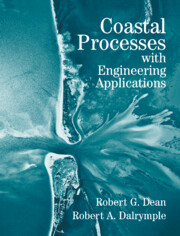Book contents
- Frontmatter
- Contents
- Preface
- Acknowledgments
- PART ONE INTRODUCTION TO COASTAL PROCESSES
- PART TWO HYDRODYNAMICS OF THE COASTAL ZONE
- PART THREE COASTAL RESPONSE
- 6 Field Measurement Techniques and Analysis
- 7 Equilibrium Beach Profiles
- 8 Sediment Transport
- 9 Miscellaneous Coastal Features
- 10 Modeling of Beaches and Shorelines
- PART FOUR SHORELINE MODIFICATION AND ANALYSIS
- Author Index
- Subject Index
7 - Equilibrium Beach Profiles
Published online by Cambridge University Press: 29 May 2010
- Frontmatter
- Contents
- Preface
- Acknowledgments
- PART ONE INTRODUCTION TO COASTAL PROCESSES
- PART TWO HYDRODYNAMICS OF THE COASTAL ZONE
- PART THREE COASTAL RESPONSE
- 6 Field Measurement Techniques and Analysis
- 7 Equilibrium Beach Profiles
- 8 Sediment Transport
- 9 Miscellaneous Coastal Features
- 10 Modeling of Beaches and Shorelines
- PART FOUR SHORELINE MODIFICATION AND ANALYSIS
- Author Index
- Subject Index
Summary
During the 1970s and 1980s, the shorefront hotels and businesses at Ocean City, Maryland, an important recreational beach on the East Coast of the United States, were jeopardized by a combination of slow, pervasive shoreline erosion and by their imprudent nearness to the shoreline. Additionally, the beaches were too narrow to accommodate the numerous summer tourists.
Various measures had been attempted to maintain the beaches in the past, including beach scraping and extensive groin construction. Neither of these approaches addressed the basic problem of an inadequate amount of sand in the system and the presence of Ocean City Inlet to the south. Thus, another method was needed, and, in 1989 and 1991, the beaches were nourished with a total of 5,000,000 m3 of sand taken from far offshore. These beach nourishments increased the beach width by 60 m. Severe storms occurred in November 1991 and January 1992, resulting in substantial reduction in this beach width. This spawned the usual criticism that the nourishment project had failed and had not been a wise use of public funds. However, subsequent surveys reported by the U.S. Army Corps of Engineers established that 90 percent of the nourishment sand was still in the project area but had moved offshore by the natural profile response to storms. In fact, the storms were variously referred to as 100- and 200-year events. The local assessment was that the fill had prevented more than $93 million in storm damages and had salvaged the $500 million in tourist revenues in the subsequent summer season.
- Type
- Chapter
- Information
- Coastal Processes with Engineering Applications , pp. 162 - 209Publisher: Cambridge University PressPrint publication year: 2001
- 3
- Cited by



